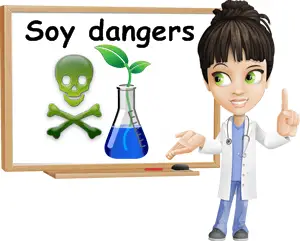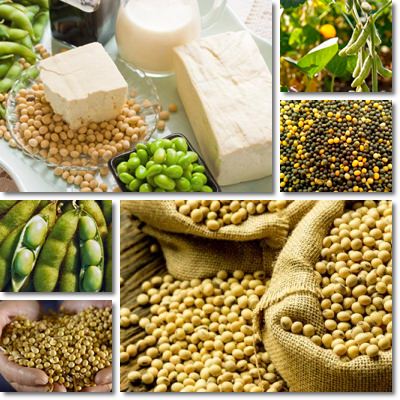Soy consumption is widely encouraged nowadays as it allegedly offers more health benefits than meat or other vegetables. The legume is a major cost-reducer in the food industry and added to absolutely everything from cold meats and biscuits to dairy and infant formula. Nonetheless, aside from the fact that it is almost entirely genetically modified, soy is full of estrogen-like compounds with a serious impact on human and ecosystem health.
The food industry relies heavily on soy to cut back on production costs and time, but is simultaneously risking our health both by altering plant DNA for the purpose of generating prompt mutations to the companies’ financial benefit and by encouraging us to increase our intake of phytoestrogens, plant forms of the human female hormone called estrogen. What does this mean? Simply put, it means that soy consumption may prove dangerous, if not for the general population, then at least for large categories of people.

Why is soy bad for you?
Some of the health risks we expose ourselves to when including soy and soy products into our (almost) daily diet may include:
1-Increases breast cancer risks
Research has showed that the high amounts of isoflavones (estrogen-like compounds) in soy encourage the abnormal growth of breast tissue, increasing the risk for breast cancer. Breast cancer is a hormone-sensitive type of cancer and the consumption of foods containing estrogen-like substances such as soy, even worse, soy dietary supplements, is believed to increase breast cancer incidence.
Studies suggest this to be true for North and South American, European and African populations. At the same time, eating soybeans and soy products appears to reduce the risk and incidence of breast cancer in Asian women, despite the fact that they consume up to 20-30% more soy. However, it is suggested that a high intake of soy over extended periods of time increases the risk for other cancer forms in Asian populations (pancreatic, stomach, bladder and kidney cancer).
Research also suggests that women at the age of menopause are at higher risk of developing breast cancer should they be taking soy-based supplements, eating great amounts of soybean and soy products. The incidence is just as high as that for women prescribed hormone therapy. The reason for this is the high amounts of estrogen-like compounds in soy and soy supplements which trigger the abnormal tissue growth.

2-Suppresses thyroid activity
The same isoflavones thanks to which soy is hailed as a miracle-food have been shown to exhibit goitrogenic effects. In other words, a high intake of soy disrupts the normal functioning of the thyroid gland, reducing its hormone production. Thyroid function suppression is accompanied by symptoms such as constipation, drowsiness and goiter. The latter is the result of the pituitary gland promoting thyroid tissue growth.
Symptoms of thyroid problems are more evident in individuals already struggling with hypothyroidism (find out more about hypothyroidism or an underactive thyroid). What is interesting is that while the consumption of high amounts of soy over extended periods of time, as encouraged by Asian cuisine, puts one at risk for thyroid cancer as well. Other goitrogenic foods are raw cassava, pine nuts, flax seeds, spinach, millet, sweet potatoes and vegetables in the cabbage family.
3-Endocrine disruptor, disrupts hormonal balance
Soy is rich in plant phytoestrogens called isoflavones. When eaten in great amounts over large periods of time, these estrogen-like compounds begin messing with our hormone balance. It has been observed that newborn girls fed soy milk formula as well as young girls fed soy and soy products regularly reach puberty considerably earlier, have their first menarche at young ages (8, 9, 10, 11 years old) and exhibit an increased incidence of reproductive system problems such as infertility, ovarian cancer, polycystic ovarian syndrome as well as breast cancer. A high intake of soy and soy products does the same for adult women and even men, with some categories being more prone to such health problems than others.
4-Linked to male and female fertility problems
Both men and women who eat large amounts of soy regularly are at a higher risk of developing fertility problems. In men, estrogen compounds such as the isoflavones in soy can cause a serious drop in testosterone levels, ultimately resulting in reduced fertility or even infertility. In women, soy overwhelms the body with estrogen-like compounds, increasing the incidence of fertility problems, possibly causing endometriosis or polycystic ovarian syndrome.
5-Negative effects on the brain
Soy has been found to alter brain patterns in newborns and young children. Feeding babies soy-based milk formula is believed by a growing number of researchers to alter brain activity in newborn baby boys and trick their body to believe it should develop female or ‘less male’ characteristics. It is feared that baby boys fed soy-based formula will have problems developing specific male brain patterns such as spatial perception or male physical traits, resulting in a leaner, more feminine body, less body and face hair, softer voice and so on. Both boys and girls exposed to soy-based formula show learning problems from very young ages, an acute emotional sensitivity, as well as thyroid deficiencies and digestive problems.
6-Responsible for mineral deficiencies
Soybeans are a great source of dietary fiber, while soy products contain phytic acid. Eating too much roasted soybeans, for example, will result in vitamin and minerals deficiencies because of their high dietary fiber content. At the same time, the phytic acid in soy products binds to dietary minerals such as zinc, calcium or iron, making them harder to absorb and encouraging the onset of mineral deficiencies.
7-Is a common allergen
Soy is a fairly common allergen that affects both adults and children. Although allergic reactions are often mild, it might be best to avoid soy, soy products and foods at risk of being contaminated with soy (cereal bars, candy, chocolate etc.) to prevent anaphylaxis, a life-threatening form of allergic reaction.
8-It is almost entirely GMO, genetically modified
Soy is over 90% genetically modified, with exact figures situating at 94-96%. Why is GMO (genetically modified) soy bad for us? Genetically modified soy crops are obtained through a number of special procedures. A safe way of obtaining quality soy and a good yield is to breed only soy varieties with the most desirable traits. This is called selective breeding and it results in superior offspring, or quality soy crops.
But other less friendly procedures may be employed, such as gene transfer or radiation. For instance, they transfer a gene from a bacteria to soy to make it resist certain herbicides or expose the seeds to radiation in order to encourage mutations that can potentially bring them more profit. They also use chemical mutagens such as EMS (ethyl methanesulfonate) to encourage the plant to mutate in order to obtain a higher yield or better resistance to pests.
Conclusion
Because soy is a major cost-reducer for the food industry overall, it is hurried to the market without studying its impact on human health and the ecosystem long-term. The worst part is that it is present in an incredible number of other food products which means that even moderate soy consumers are getting at least double the amount of soy from other foods.
From milk to meat products, candy, energy bars, cereal bars chocolate, baked goods, chicken broth, vegetable broth, infant formula, margarine, smoothies, baking mixes and so on, soy is in everything. Natural flavorings, thickeners, stabilizers, lecithin, starch, all may contain soy. As a result, eating soy-free or, at least, less soy, can be problematic.
While researchers agree that a moderate consumption of soy and soy products is not harmful in any way, the horrors our land suffers to yield this crop companies abuse and push down our throat are dreadful. Radiation, mutation, chemicals and hormones, all fed to people, animals and integrated in the earth for profit. There is a better way and there are better alternatives to soy, so why expose ourselves, our children and the ecosystem to unnecessary harm when we have other options?
